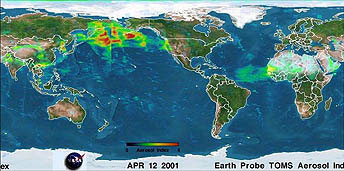Silver Contaminates 'Pristine' North Pacific

A survey announced today found the highest levels of silver contamination ever observed in the ocean. The high concentrations are in the North Pacific, a region thought to be relatively pristine, scientists said.
The extent of contamination -- 50 times higher than the natural level of silver that should be there -- is not thought to be toxic to marine life, but it illustrate the global impact of industrial emissions, scientists said.
"The most likely source of the silver contamination is atmospheric emissions from coal burning in Asia," said Russell Flegal, professor of environmental toxicology at the University of California, Santa Cruz. "Silver concentrations in the North Pacific trace the atmospheric depositions of industrial aerosols from Asia, with the highest concentrations in those waters closest to the Asian mainland."
The study involved samples collected during a 35-day cruise in 2002. The results were reported in the March 9 issue of Geochemistry, Geophysics, Geosystems, an electronic journal published by the American Geophysical Union and the Geochemical Society.
Scientists may be able to use silver as a tracer element for tracking the fate of industrial emissions from Asia, said study member Mara Ranville, who was a graduate student in Flegal's lab when the samples were collected.
"Atmospheric pollution from Asia is becoming a serious problem for the western United States, and this may be a valuable tool for tracing those emissions, both in the atmosphere and in the water," Ranville said.
Burned coal also produces nitrogen and sulfur compounds that contribute to acid rain and smog. Pollution from China rides prevailing westerly winds across the North Pacific, scientists say. A previous study by the same group found high levels of mercury in rainfall on the U.S. West Coast, also thought to be linked to Asian coal burning.
Get the world’s most fascinating discoveries delivered straight to your inbox.
"Unlike mercury, silver is not a human health concern," Flegal said. "But silver is second only to mercury in its toxicity to marine invertebrates."
Previous studies have monitored dust from China traveling the America, and even African dust that makes its way to Florida.
The United States burns coal, too, and emissions are known to drift eastward. A study released last month found ozone levels in the European Alps jumped 33 percent when a carefully monitored cloud of U.S. pollution blew across the Atlantic.
"We found by far the highest levels of silver in the North Pacific," Flegal said. "Even though the Atlantic Ocean is subject to industrial emissions from North America and Europe, the amounts are small compared to what goes into the Pacific from Asia."

